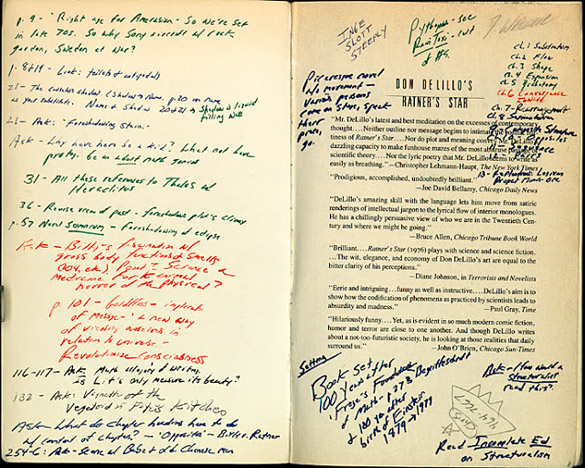Humanities
MIT's Annotation Studio empowers readers and writers
translating an ancient literary practice into the digital age
 Marginalia by David Foster Wallace, on a copy of a Don DeLillo novel
Marginalia by David Foster Wallace, on a copy of a Don DeLillo novel
Among the Humanities endeavors at MIT are a range of projects in the digital humanities — a field of research, teaching, and creation that couples the disciplines of the humanities with computational approaches. Digital humanities projects often use methodologies and techniques such as web-based media, digital archiving, data mining, geo-spatial analysis, crowdsourcing, data visualization, and simulation.
At MIT, digital humanities practioners use digital tools and “big data” to investigate research questions (many that can only be asked with the speed of the new tools) while also presenting scholarship through, and within, new media forms.
Take a look at Annotation Studio, one of the innovative MIT SHASS humaniites program that is empowering readers and writers — both in and beyond the classroom.
•
TIME WAS, AVID READERS WROTE NOTES in the margins of much-thumbed books, adding their own thoughts to the author’s and enriching the volume for future generations. John Adams, for example, is so well known for the witty repartee he exchanged with his own library that whole essays have been written about his annotations and comments.
The popularity of e-books could sound the death knell of such illuminating marginalia, but the Annotation Studio, a project developed by HyperStudio (the MIT SHASS lab for digital humanites), promises to improve upon traditional techniques for entering marginalia and side notes in books — enabling readers not only to annotate texts across media, but also to share comments with others and to enhance them with links, images, video, and audio.
The power of annotation
Recently, HyperStudio received a Digital Humanities Start Up and a Digital Humanities Implementation Grant from the National Endowment for the Humanities to continue developing and implementing "Annotation Studio," an online tool designed to enhance student learning through annotation of digital texts, images, and video resources.
“Annotation is a very ancient practice; it’s probably been around as long as reading,” says James Paradis, Robert M. Metcalfe Professor of Writing and one of the two project directors. “As text becomes digitized, it becomes more difficult to write comments. We think there’s value to letting people annotate in the same space.”
A digital descendent of Miximize
Annotation Studio grew out of an earlier program called Miximize, which was developed at MIT in 2010-2011 in close collaboration with Wyn Kelley, Senior Lecturer in Literature. Kelley had her class use Miximize to insert notes, definitions, and references into a digital version of Mary Shelley’s Frankenstein.
Annotating works digitally has many advantages over old-fashioned note-taking, Kelley says. “It gives students so much more control over their work and so much more connection to the text. And, it relieves them of their inhibitions about writing. I see much better writing when our students use digital annotation."
Of the annotation tools, one of Kelley's students says, "I am actually writing down ideas while reading, and by writing them down I’m looking deeper into the text — not like when I just read the book and said, 'Oh, it may mean this.' Now it's more, 'Oh what does this mean?” Then I keep asking questions because I am annotating. I am thinking about the text more."

"Annotating works digitally gives students so much more control over their work and so much more connection to the text. And, it relieves them of their inhibitions about writing. I see much better writing when students use digital annotation."
— Wyn Kelley, Senior Lecturer, MIT Literature
"I am actually writing down ideas while reading, and by writing them down I’m looking deeper into the text — not like when I just read the book and said, 'Oh, it may mean this.' Now it's more, ' Oh what does this mean?” Then I keep asking questions because I am annotating. I am thinking about the text more."
— Student in Kelley's MIT Literature class
Using an open software system
Recognizing the potential of this digital humanities project, researchers in HyperStudio decided to expand the program’s capabilities, and Annotation Studio was born.
“Every commercial textbook publisher is trying to create this, but they deliver proprietary stuff — not something you can adapt and change,” Paradis says. “We use open software.”
To date, Annotation Studio has been used in writing, foreign languages, and literature classes at MIT, and the feedback from students has been positive, according to Kurt Fendt, executive director of HyperStudio and project director. “Students want to use annotation not only for class work but also for their own writing,” he says. Faculty using Annotation Studio in the classroom, such as Kelley, have been a central part of the pedagogical development team, providing feedback and suggestions to improve the tool.
Engaging in the digital age
With the help of the NEH grant, Fendt and Paradis aim to further develop the capabilities of Annotation Studio and to make the program broadly available. “We’re sharing everything,” Fendt says.
Other universities have already begun using Annotation Studio in their own courses, or have taken the code as the basis for their own projects — an indication that digital annotation fills a clear need. “Ten years ago, people struggled to read digitally, now some prefer it,” Paradis says. “We want to return to people the capability of engaging with text — in a digital age.”
Suggested Links
White paper on the MIT Annotation Studio
How MIT is addressing the challenges of digital learning in the Humanities
Commentary by Wyn Kelley, MIT Senior Lecturer in Literature
Annotation Studio | HyperStudio website
Humanities at MIT
Story prepared by MIT SHASS Communications
Editorial and Design Director: Emily Hiestand
Senior Writer: Kathryn O'Neill
Communications Assistant: Kierstin Wesolowski
